Faule Haut Skipper Ingo meets his wife after 19 (nineteen !) month of sailing half way around the world. Great joy and honeymoon on Faule Haut.
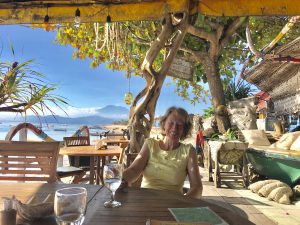
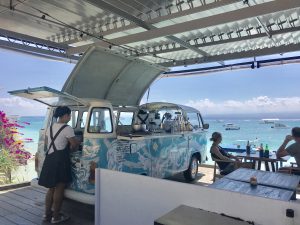
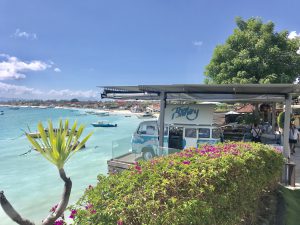
A Circumnavigator‘s Yacht

After having sailed 1,200 nm from Darwin, Australia, singlehand Skipper Ingo reached Bali Marine, Bali, Indonesia just in time to meet his wife Gerdi.
A question to all the technicians/mechanics:
When do things/materials break or fall apart? Under load, or at the state of rest? Under load! Yes! But not so on Faule Haut.
I experienced strong winds for over three weeks now, almost every day on my cruise from Darwin, Australia to Bali, Indonesia. In those winds I hardly used the main sail, only the storm jib and sometimes as well a little piece of genoa. Winds were around 35 to 40 knots with the exception of one entire night, when it got up to over 60 nasty knots, when even the autopilot refused to do its work. On June 7th the wind calmed down to 25 knots and I got the main sail up as well. Next morning Faule Haut ran into a dead calm and got stuck in the doldrums. Wind from dead astern, 3 to 5 knots, that’s close to nothing. I left the sails up, making one knot of speed over ground but not because of the wind, but because of the current that went – luckily – the same direction as I wanted to sail.
On June 8th I was in the pantry standing at the stove, when suddenly I heard a strange crack and a washer fell through the open deck-light/window on my head. I got on deck to see what had happened and saw the boom disattached from the mast. A safety pin that secured a bolt which is supposed to hold the boom to the mast was gone. The bolt had slid out so that the boom had no connection to the mast anymore.
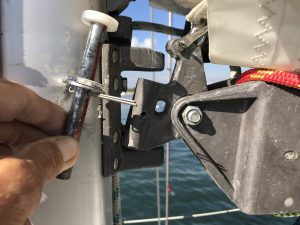
The bolt that fell out with a (new) locking pin.This happened in the doldrums, meaning no wind going. No load or force working on the mast. Had this happened a few days earlier when I was under full sails in those strong winds, “the sh!t would have hit the fan”.
Definitely – my lazy jack lines would have been torn off, both, starboard and port. They are not sized to support the load of the boom plus the main sail plus the force of the wind blowing into the open sail. And most likely the vang/boom kicker would have broken. Had this happened during the stormy night, when it was blowing over 60 knots, the main sail would also have been torn off the sliders that run up the mast leaving me with a torn off sail, unable to repair on the open sea. The boom would have bounced violently against the mast causing further damage. You would agree if you had seen the forces that were working on deck in 60 knots of wind, when you almost get blown off the deck.
So it seems, physical laws do not apply on Faule Haut but are suspended from time to time. On Faule Haut things don’t fall apart under load, but at rest, in order to protect the boat and her skipper!
Go ahead and draw your own conclusion!
(Exactly the same thing happened a few weeks ago with my old anchor, that broke apart while it was resting on deck on a tarpaulin and not on the seabed holding the boat (see story on www.faule-haut.de 2019-04).
(And – for Patrick: No! It was not the hobgoblin/Klabautermann that helped me! )
Sailed some 800 nm from Thursday Island to Darwin. This time the cruise was easy with neither problems nor thunderstorms.
von Ingo
Faule Haut mit Skipper Ingo ist überwältigt von der Hilfsbereitschaft seiner Freunde.
Die Bitte um Spenden zur Wiederherstellung der Dächer der Dominikanischen Schule, die letztes Jahr vom Hurricane Maria zerstört wurden, brachte Spenden von 3,805.- € zusammen.
Wie versprochen, die eingehenden Spenden bis zu einem Höchstbetrag von 1.000,- € zu verdoppeln, legte die Faule Haut nochmals 1.000,- € drauf, sodass vor einigen Tagen der Betrag von 4.805,- € überwiesen wurde auf das Konto der Schule.
Faule Haut sagt ein dickes fettes
DANKESCHÖN
an alle Freunde und Spender.
Gott segne euch alle.
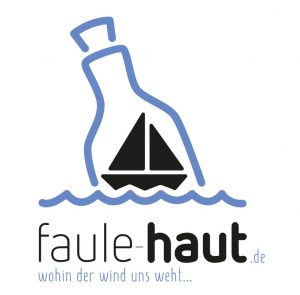 Über den Einsatz des Geldes zur Herstellung der Dächer wird die Faule Haut hier näheres zu gegebener Zeit bekanntgeben.
Über den Einsatz des Geldes zur Herstellung der Dächer wird die Faule Haut hier näheres zu gegebener Zeit bekanntgeben.
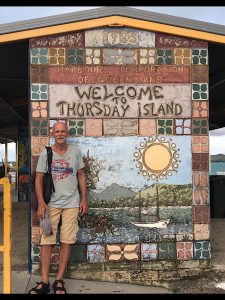
It started so easy during the first six days when we had fair winds up to 30 knots from the back. After having sailed 680 nm we passed “Mellish Reef”, a reef in the middle of nowhere, between New Caledonia and Australia where me made an overnight stop and dropped the anchor over 7 m of crystal clear water and white sand (17°24.861’ S 155°51.689‘E). We, my crew Louise (Danish) & Theo (French) drove to the corals with the dinghy and had a marvelous snorkeling time with mantas, stingrays, lotsa other fish and even a three meter shark beside us. That reef even had a little island of about 500 m length, just plain sand, like a sand dune. We tried to get there with the dinghy but the corals all around the island made it impossible. After hitting the corals with the prop I decided to give up. To risky. I didn’t want to mess up my new outboarder. So we did some more snorkeling in the corals.
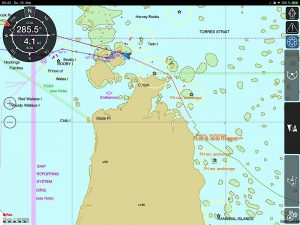
When we left, we only had wind for two hours and then we got stuck in the doldrums, took all sails down and drifted with the current – that went in our favor, that means it went the same direction we wanted to go – till the evening came. Suddenly we got wind again and raised the sails, but we got way too much of it. At around 21:00 it became nasty and nastier by the hour. During the night we encountered winds up to 60 knots. We only had 40 to 60 cm of the genoa rolled out, just enough to keep the boat steerable. And with just this little sail, smaller then a bathing towel, we made over 6 to 7 knots of speed in winds between 40 and 60 knots (that’s up to force 11 on the Beaufort scale (German: “orkanartiger Sturm”). The waves got up to five meter and sometimes we thought the boat would fall apart when a big breaking wave crashed noisily against the hull. Luckily, this boat is built to withstand these forces. The autopilot (what a sissy!) refused to work. It could not handle these winds anymore so I had to steer all through the night manually for ten hours without a single break, fighting to stay awake. Steering a car for ten hours without a pause is easy-peasy in comparison. My crew was not experienced enough to take over. They were in their berth trying to get some sleep, while I was sitting in the rain, getting pooped several times, keeping the boat on track. That night was a nightmare for me and I was greatly relieved when the wind dropped to 35 kn, which the autopilot could handle again. The wind stayed at around 35 knots for two more days. Just one to two meter of the genoa rolled out kept us going.
THE GREAT BARRIER REEEF (GBR)
Early in the morning on the 14th of May 2019 we reached our entrance (“Reine I Entrance”, 11°39.085 S, 144°07.500 E) to the Great Barrier Reef.
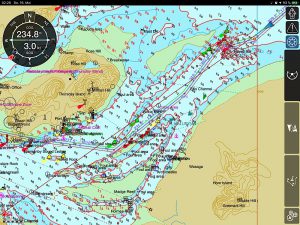
Knowing that thousands of boats shipwrecked throughout the ages on this GBR, I was not relaxed getting into this area, especially at night time. We had to be vigilant around the clock. We wanted to avoid sailing at night but to cover the distance of 138 nm over the reef up to Thursday Island only in daylight didn’t work either. There was no anchoring spot right in the middle of the GBR. Finally when we got to the coast of Australia we were looking for a suitable place to anchor. It had to be spot with sand or mud, big enough and free of corals to swing with the boat in changing wind and current conditions. Within the reef you have areas with up to 6 knots of tidal stream, changing directions depending on ebb or height tide. I wanted the water depth to be below 12 m in order to be able to dive down the anchor and check it before going to bed on this notorious reef.
On the 15th of April 2019 at 9:30 in the morning we found a spot just 200 m away from the coast in position 11° 05.793‘ S, 142° 47.418‘ E. But because it was morning, we didn’t want to stay long for we wanted to make use of the daylight. So we only had a pause for 4 hours when I tried to find some sleep, because I hadn’t really slept for the last five days. After noon we continued sailing towards Cape York
Close to Thursday Island we had to pass through narrow channels, one of which had a charted water depth of 2,30 m, while my keel goes down to 2,20 m. That just leaves space for a bottle of red wine (horizontally ) underneath the keel. To be able to maneuver fast, we had taken the sails down and were running under motor. We had a 6 knots tidal stream with us making 8 knots of SOG (speed over ground) going only 2 knots speed through the water. I was sweating blood going through this channel, relying solely on the accuracy of my electronic chart. It was 3:00 in the morning and still dark but we made it and happily dropped the anchor an hour later.
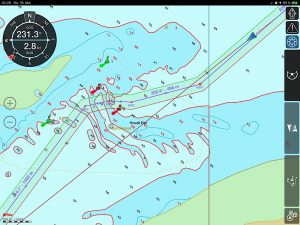
Finding sleep at anchor with our quarantine flag raised – finally – after close to 16 days of sailing and being in a state of alert for 24 hours a day, was a great relief for me.
Next morning I called customs/immigration via sea radio. They told me that none of us is allowed to go ashore before they have cleared and inspected our boat. They announced their coming for 3:00 p.m.
They showed up in time with 4 officers (one kept on their boat), inspected the boat, checked and took all our rubbish (which we had to present separately: plastic – metal/cans – organic) and did all the paperwork and we could take the quarantine flag down, being legal guests in the land „down under“, even though they still ordered me to come to their office the next day.
I expected to find a better infrastructure here at Thursday Island. There are no ship chandlers here. No convenient place to fill up my empty water tanks with a hose. I will have to fill up my tanks (500 liter !) by transporting cans with the dinghy from the shore to the boat. But I’m used to this, for it was the same at Bora Bora, Tonga, or Tahiti. This will be my Sunday morning work, which won’t collide with going to church, because, being a member of the Seventh-Day-Adventist Church, I went to church yesterday morning (according to the bible on Sabbath/Saturday) already.
VISITING THE SDA CHURCH
When I asked a man in a pickup where I can find the SDA Church he invited me to jump in his car, he would take me there. (He said, he was the harbor master (even though there weren’t any harbors, just wharfs ???) Friendly – hey!?
So far the Australians I met were nice, relaxed and friendly. Also customs and immigration, though being very strict, were very friendly and sympathetic people.
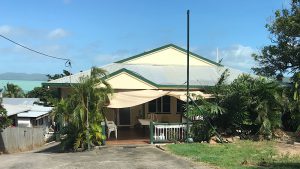
At the little “Torres Strait SDA Church” (12 members), I was welcomed very cordially by everyone and was invited to stay for lunch with them. We had good talks. They were very interested in my cruise and I had to answer a lot of questions. The church is situated on a little hill. So from their window we had a good view at the Faule Haut at anchor.
Above: Torres Strait SDA Church
They got shocked and laughed when they heard that I was swimming around my boat. Why? Because there are crocodiles in the water!
NOBODY swims here except a German dumb a##. I already was wondering the day before, that I saw nobody swimming here. I also noticed, that at the dinghy dock, my dinghy was the only inflatable one. All other dinghy or boats had a rigid fiberglas or aluminum hull. One bite of a crocodile in the tubes of the dinghy and …ppffffffffff… you go down under in the land down under.
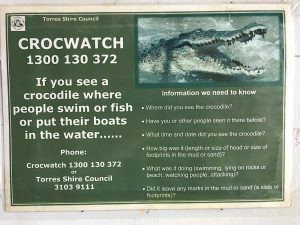
Chappy, the preacher, told me that the biggest reported crocodile here was about 24 feet long, that’s 8 meters. He also showed me a video clip on his iPhone that showed a fisherman pulling his catch ashore right here, when a big crocodile came out of nowhere like a flash stealing his catch. Frightening!
Now I know. You see – going to church might save your life, because you get some vital information there.
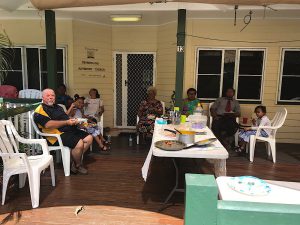
I won’t bath and swim here any more. On the day of my arrival I spent about an hour in the water, cleaning the hull at the waterline. I wanted it to look good before customs would come. Before going to church I also swam, cleaned and got rid of the soap jumping into the water. Looks like I was close to another catastrophe. I have to get more information about the countries and areas I’m going to visit.
After lunch and the talks, Chappy took me in his pickup to the dinghy dock.
Thanks to everybody at the church. I enjoyed the service and your company. See you all.
I don’t want to strain or wear out the word “miracle” again, but, please judge yourself what this was:
Being on the open sea on May 15th, I found a rusty bolt on deck at the stern of the boat. I was thinking where it came from, but I could not figure it out. I thought, someone must have thrown it on my boat at the last anchorage and I forgot about it.
Ever since I got the boat, I was thinking about replacing my old anchor because there is a new generation of anchors on the market with a new design which has been tested and compared to the commonly used predominating anchors on the majority of boats. YouTube videos show the advantage of these anchors over all the others. It’s called ROCNA. In Opua, New Zealand, all the boat equipment cost roughly 30 or 50 % less than in Germany. This was a good opportunity to buy the anchor I wanted to have so badly. So I bought that ROCNA, took off the old anchor and attached the new one on the chain. The old one I put on top of the tarpaulin that covered my spare sails on deck, close to the bow. I tied it up with ropes so that it wouldn’t move or fall off the deck.
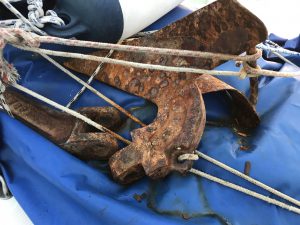
When I got back from the “bio security dock” at Nouméa, New Caledonia, this morning, I sailed to a recommended anchorage and felt happy and safe when I dropped this new ROCNA anchor for the second time. When I went back on deck from my ground tackle to the cockpit I passed my old anchor and saw that is has virtually fallen apart. The anchor that I had tied with ropes on top of the tarpaulin as ONE piece two weeks ago, was resting there in TWO pieces. The shaft had come of the plough. A bolt, which was supposed to hold these two parts together, was gone. I was that rusty bolt that I had found a few days earlier at the stern. It must have fallen out during my cruise, while the anchor was resting on deck.
I have been using and trusting this anchor for more than 15 months, and was shocked to see it fallen apart. Imagine this – my anchor fell apart – resting on deck – not being used – not under load on the seabed. For sixteen months Faule Haut had been in danger to drift away from the anchorages and get blown against some rocks to crash or get blown away towards the open sea (when I was ashore).
A nightmare. Am I exaggerating when I say that I escaped a catastrophe here? I had to fall on my knees to send a bit THANK YOU to my friend up there.
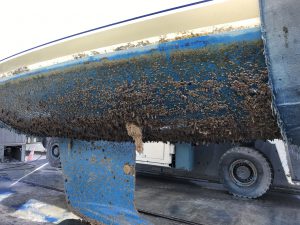
In The Bay of Islands where I had to wait the closing of the hurricane season, I used the free time to work on the boat. I installed a new windlass, gas stove, and did some minor repairs.
Luckily – at the boat yard at Opua, they offered special deals for cleaning the bottom of the boat, including the haul out and splashing back in. I jumped on that offer, because the boat looked terrible underneath.
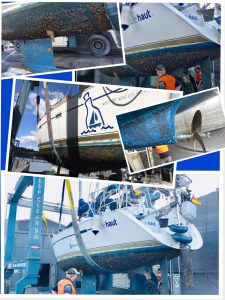
Sign in to your account
Lost password?